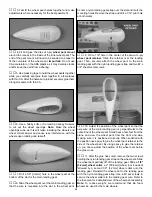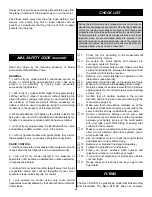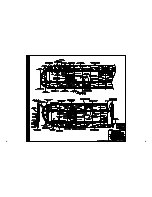
At this stage the model should be in ready-to-fly condition
with all of the systems in place including the motor, prop,
electronic speed control, motor battery and the radio
system.
❏
1. Use a felt-tip pen or 1/8"-wide tape to accurately mark
the C.G. on the top of the wing on both sides of the fuselage.
The C.G. is located 2-5/8" [66.7mm] back from the leading
edge of the wing.
❏
2. With the wing attached to the fuselage, and all parts of
the model installed (ready to fly), place the model upside-
down on a Great Planes CG Machine
™
, or lift it upside-down
at the balance point you marked.
❏
3. When the Ryan STA EP is properly balanced, the stab
will be level. If the tail drops, the model is “tail heavy” and the
motor battery must be shifted forward or weight must be
added to the nose to balance. If the nose drops, the model
is “nose heavy” and the motor battery must be shifted aft or
weight must be added to the tail to balance. If possible,
relocate the motor battery to minimize or eliminate any
additional weight required. If additional weight is required,
use Great Planes (GPMQ4485) “stick-on” lead. A good
place to add stick-on nose weight is inside the cowl or on the
bottom of the stabilizer. Begin by placing incrementally
increasing amounts of weight in the fuse until the model
balances. Once you have determined the amount of weight
required, it can be permanently attached. Make sure the tail
weight does not interfere with the movement of the elevator
pushrod.
If moving the motor battery forward or aft will balance the
plane without adding additional weight, mark the battery tray
or the fuselage inside where the aft end of the battery
should be placed. This will allow you to position the battery
correctly before each flight.
❏
4. IMPORTANT: If you found it necessary to add any
weight, recheck the C.G. after the weight has been installed.
No matter if you fly at an AMA sanctioned R/C club site or if
you fly somewhere on your own, you should always have
your name, address, telephone number and AMA number
on or inside your model. It is required at all AMA R/C club
flying sites and AMA sanctioned flying events. Fill out the
identification tag on the decal sheet and place it on or inside
your model.
Follow the battery charging instructions that came with your
radio control system to charge the batteries. You should
always charge your transmitter batteries the night before
you go flying, and at other times as recommended by the
radio manufacturer.
1. Most motors will benefit from a short “break-in” by running
the motor without the propeller for at least 15 minutes. This
will seat the motor brushes on the commutator, insuring that
the motor will provide full power for your first flight and
extend the life of your motor. If you notice a decrease in
motor power after several flights, it may be due to carbon
build-up on the brushes or commutator. To remove this
build-up, repeat the above break-in procedure.
2. Using multiple battery packs to run the motor for
successive flights may cause the motor to become
excessively hot. We recommend at least a 10-minute cool-
down period between flights.
PROPER CARE OF YOUR MOTOR
Charge the Batteries
Identify Your Model
PREFLIGHT
This is where your model should balance for your first flights.
Later, you may wish to experiment by shifting the C.G. up to
3/16" [4.8mm] forward or 3/16" [4.8mm] back to change the
flying characteristics. Moving the C.G. forward may improve the
smoothness and stability, but it may then require more speed for
takeoff and make it more difficult to slow for landing. Moving the
C.G. aft makes the model more maneuverable, but could also
cause it to become too difficult for you to control. In any case.
start at the location we recommend and do not at any time
balance your model outside the recommended range.
More than any other factor, the C.G. (balance point) can have
the greatest effect on how a model flies, and may determine
whether or not your first flight will be successful. If you value this
model and wish to enjoy it for many flights, DO NOT
OVERLOOK THIS IMPORTANT PROCEDURE. A model that is
not properly balanced will be unstable and possibly unflyable.
Balance the Model (C.G.)
44
Summary of Contents for Ryan STA EP
Page 7: ...7 DIE CUT PATTERNS...
Page 48: ...TWO VIEW DRAWING Use copies of this page to plan your trim scheme...
Page 49: ...B C...
Page 50: ...D A...






































